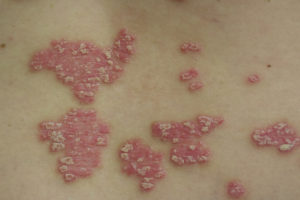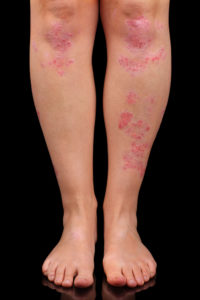 Psoriasis is a chronic, red, scaly rash that affects people of all ages. Psoriasis tends to run in families because of its genetic predisposition; however, you can not get it from another person – it is not contagious. Psoriasis affects about 2% of the population or 7.5 million people in the United States. Psoriasis occurs more often in Caucasian people. About 15% of those with psoriasis will also develop joint pain which may involve one or more joints. This is known as psoriatic arthritis.
Psoriasis is a chronic, red, scaly rash that affects people of all ages. Psoriasis tends to run in families because of its genetic predisposition; however, you can not get it from another person – it is not contagious. Psoriasis affects about 2% of the population or 7.5 million people in the United States. Psoriasis occurs more often in Caucasian people. About 15% of those with psoriasis will also develop joint pain which may involve one or more joints. This is known as psoriatic arthritis.
A person’s genetics and immune system plays a role in the disease. Not everyone with the gene associated with the disease will get it. Sometimes psoriasis is triggered and begins after an event such as an illness, skin injury, severe sunburn, stressful life event, certain medications or exposure to cold or dry weather.
There are several types of psoriasis:
- Plaque psoriasis or psoriasis vulgaris appears as red, scaly, raised patches on the skin. The patches can vary in size and often itch. Knees and elbows are common places for the patches to occur. Also, nails may become brittle, discolored, and can lift off the nail bed.
- Inverse psoriasis, also known as flexural psoriasis, involve smooth red patches that appear raw. Common areas include the inguinal folds and armpits. This type of psoriasis is most common in infants and young children.
- Guttate psoriasis involves small, red spots most commonly on the arms, legs and trunk. Sometimes this occurs after an illness such as strep throat or after a dental procedure. This may clear up on its own. Guttate psoriasis is most common in infants and young children.
- Erythrodermic psoriasis, also known as exfoliative psoriasis, causes the skin to look as if it has been burned. The skin turns bright red and cannot maintain its normal temperature. This can cause intense pain and itching as well as a rapid heartbeat. Anyone affected should seek medical treatment immediately.
- Pustular psoriasis causes pus filled bumps on the palms or soles.
 There are several ways to treat psoriasis including topical (applied to the skin) and injectable medications. The injectable medications are known as biologics. Some of the most common biologics include Enbrel, Humira, Cosentyx and Stelara. Oral medications include Otezla, Methotrexate, Soriatane and Cyclosporine. These drugs work by suppressing the part of the immune system that is critical for psoriasis to develop. Use of these medications requires us to draw blood work on a regular basis. Not everyone responds to the same medications. If we decide to treat your psoriasis with a biologic, we will work with you to determine which medication is best for you.
There are several ways to treat psoriasis including topical (applied to the skin) and injectable medications. The injectable medications are known as biologics. Some of the most common biologics include Enbrel, Humira, Cosentyx and Stelara. Oral medications include Otezla, Methotrexate, Soriatane and Cyclosporine. These drugs work by suppressing the part of the immune system that is critical for psoriasis to develop. Use of these medications requires us to draw blood work on a regular basis. Not everyone responds to the same medications. If we decide to treat your psoriasis with a biologic, we will work with you to determine which medication is best for you.
Another method of treating psoriasis is with phototherapy. Phototherapy has been used for years and is a safe method of treating psoriasis. With phototherapy, ultraviolet (UV) light pushes the inflammation away from the skin cells. We offer both full body narrow band UVB or UVA treatments as well as XTRAC laser for those patients who do not have as much skin involvement. Treatments are usually done 2-3 times per week. Our will trained staff will make sure you are comfortable during your treatment.


